Introduction:
Seeds germination tests are crucial procedures conducted by various entities involved in seed production, conservation, gardening, forestry, environmental conservation, and horticulture. These tests provide vital information about seed viability, vigor, and quality, ensuring successful plant establishment and crop production. This comprehensive guide aims to elucidate the importance, methods, and interpretation of seeds germination tests for different stakeholders.
Importance of Seeds Germination Tests:
Seed Viability Assessment: Germination tests determine the percentage of viable seeds capable of producing healthy seedlings, aiding in seed quality assessment and selection.
Seed Vigor Evaluation: Assessing the speed and uniformity of germination provides insights into seed vigor, crucial for predicting crop emergence and performance under various conditions.
Quality Assurance: Seed germination tests ensure compliance with industry standards, enabling seed companies to deliver high-quality seeds to customers.
Conservation Efforts: Seed banks and environmental organizations utilize germination tests to monitor and preserve genetic diversity, endangered species, and native plant populations.
Optimizing Planting Practices: Gardeners and horticulturists rely on germination tests to determine optimal sowing times, seed treatments, and cultivation techniques for different plant species.
Methods of Seeds Germination Tests:
Seed Preparation: Collect seeds from representative samples, remove debris, and conduct initial seed viability assessments if required.
Germination Medium: Use sterile substrates such as petri dish, Megenta box, Nursery plastic tray, moistened filter paper, sand, cocopeat, vermiculite, or specialized germination papers to provide adequate moisture and aeration.
Temperature and Light Conditions: Maintain optimal germination conditions based on species/crop-specific requirements, including temperature, R-humidity, light intensity, and photoperiod.
Germination Chambers: Utilize growth chambers, incubators, or controlled environment rooms to ensure consistent environmental conditions throughout the germination test.
Data Collection: Record daily observations of germinating seeds, including the number of seeds germinated, emergence time, abnormal seedlings, and fungal contamination.
Germination Evaluation: Calculate germination percentage, mean germination time, and other vigor indices to assess seed quality and viability.
Interpretation of Germination Test Results:
Germination Percentage: The percentage of seeds that successfully germinate within a specified period, indicating seed viability and potential crop establishment.
Mean Germination Time (MGT): The average time taken for seeds to germinate, reflecting seed vigor and uniformity of germination.
Abnormal Seedlings: Identify and record abnormal seedlings, including those with malformed cotyledons, stunted growth, or fungal infections, which may indicate seed health issues.
Seed Dormancy: Consider the presence of seed dormancy factors such as physical, physiological, or environmental dormancy, which may affect germination rates and timing.
Conclusion:
Seeds germination tests are indispensable tools for seed companies, seed banks, gardeners, forestry, environmental organizations, and horticulturists to ensure seed quality, viability, and successful plant establishment. By understanding the importance, methods, and interpretation of germination tests, stakeholders can make informed decisions to enhance crop production, conservation efforts, and sustainable agriculture practices.
Let’s connect with us for the expert seed germinations testing services at our state-of-the-art facility…

